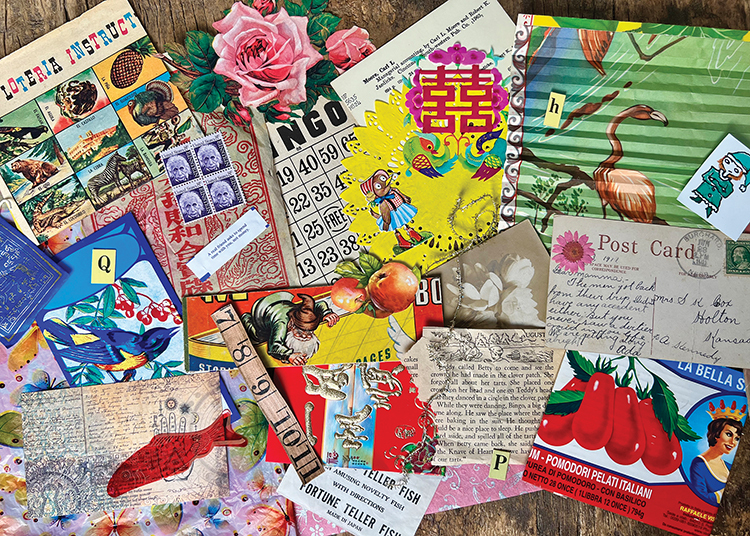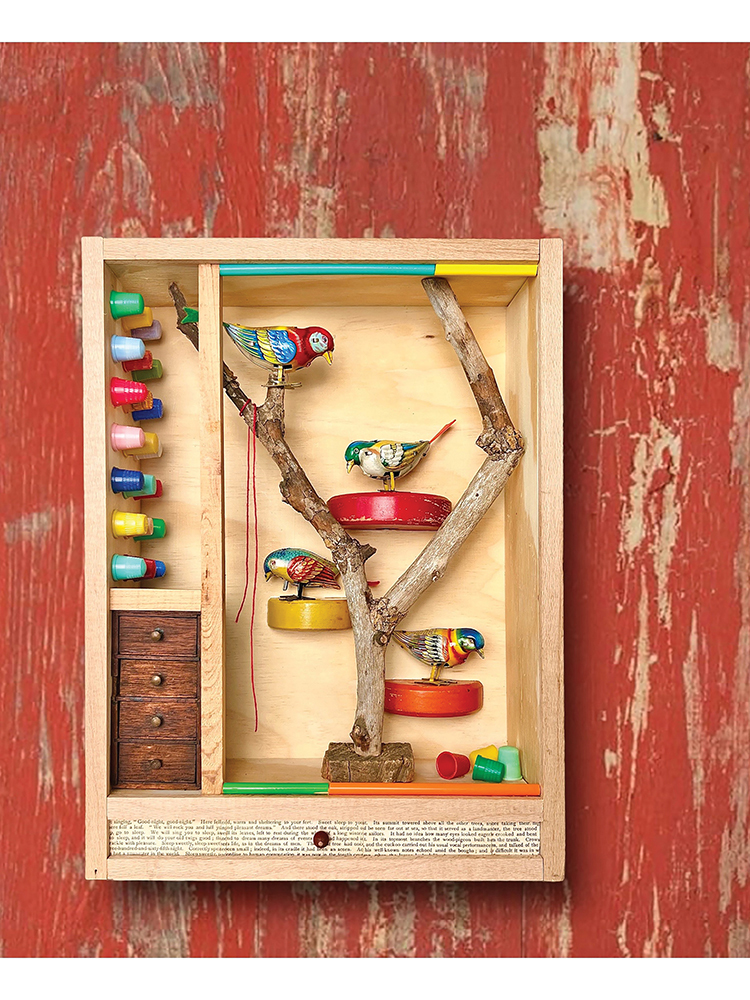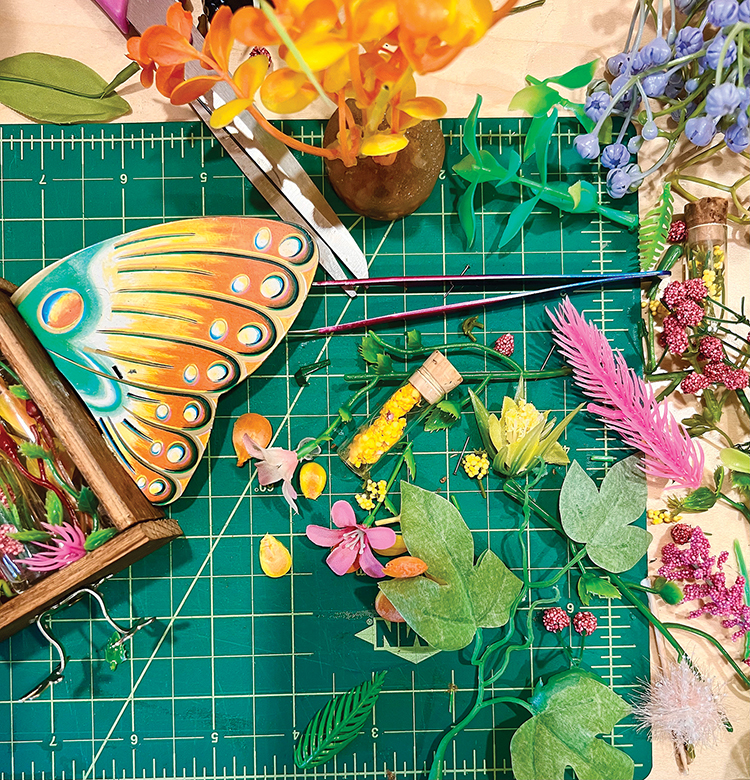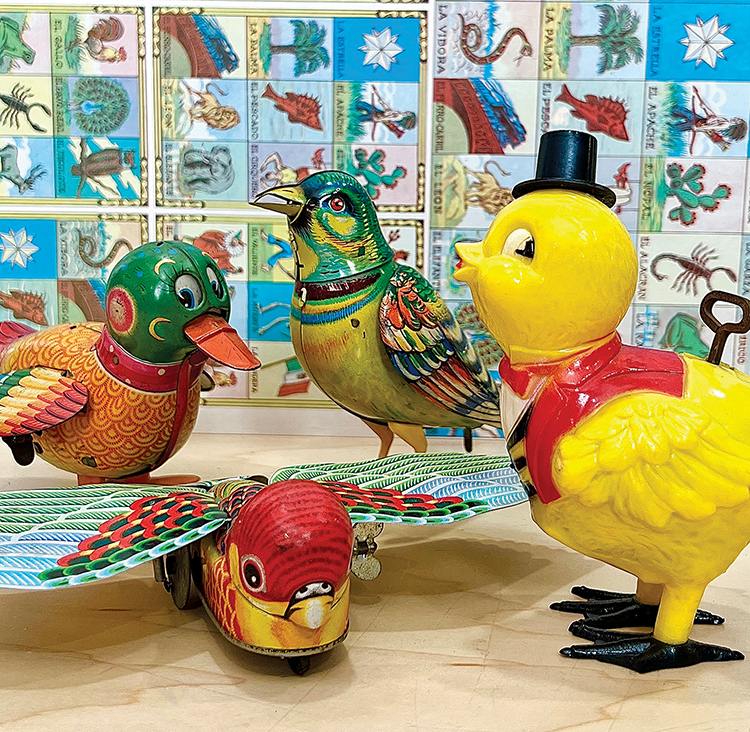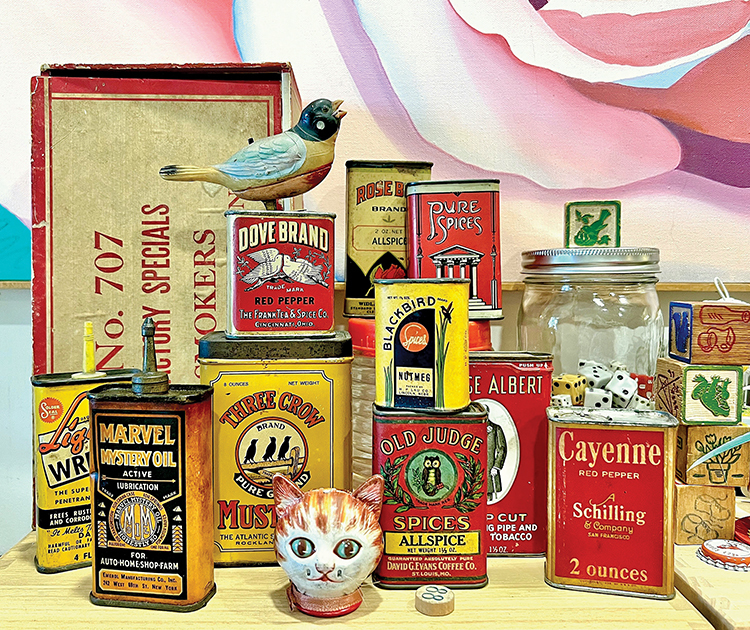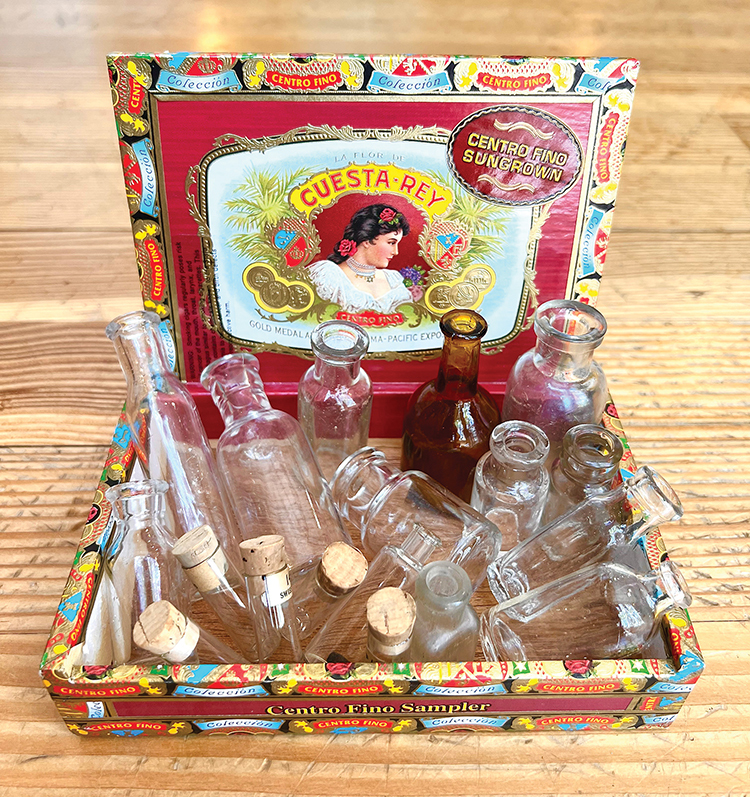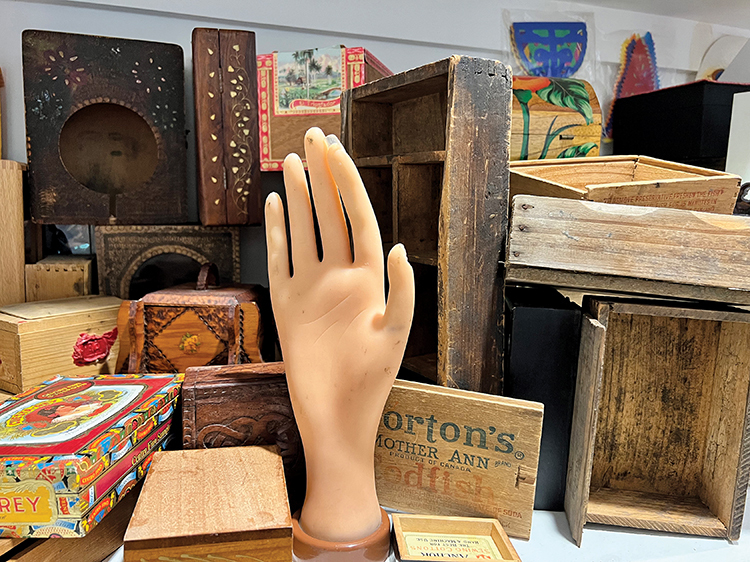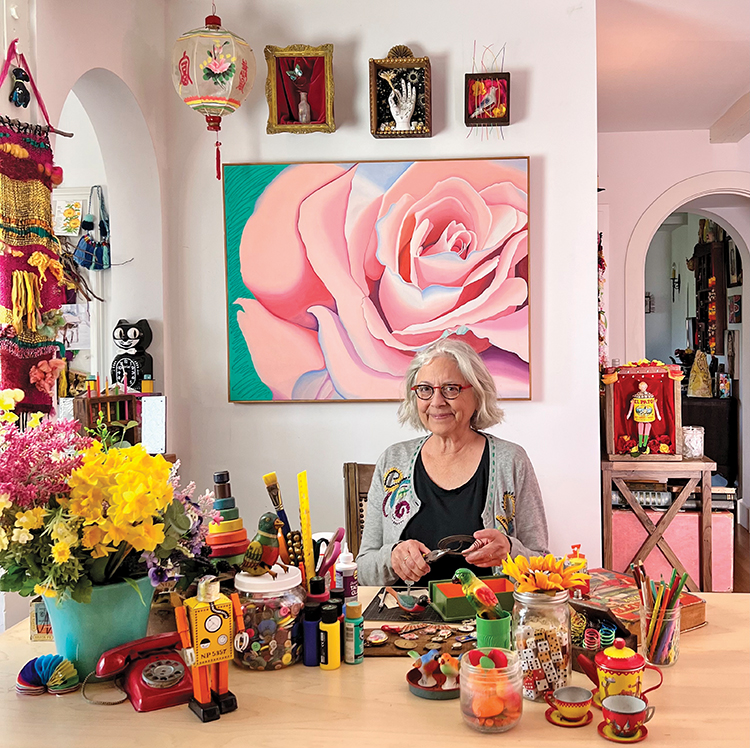
I grew up in the San Fernando Valley (a suburb of Los Angeles) when it was still filled with orange groves and neighbors rode by on horseback. My street had no sidewalks and it was safe for us neighborhood kids to ride our bikes and explore construction sites (collecting the slug cutouts from electrical boxes) and feed the ducks at the unfenced lake at the historical Encino Adobe.
Not everything was carefree, however. As a child of a Holocaust survivor, I was raised amid fear, distrust and anxiety. Beginning in childhood, creating art was my happy place. I was a tomboy who loved being outside playing kickball, but you would often find me in my room drawing, painting or building something. Art was always my favorite subject.
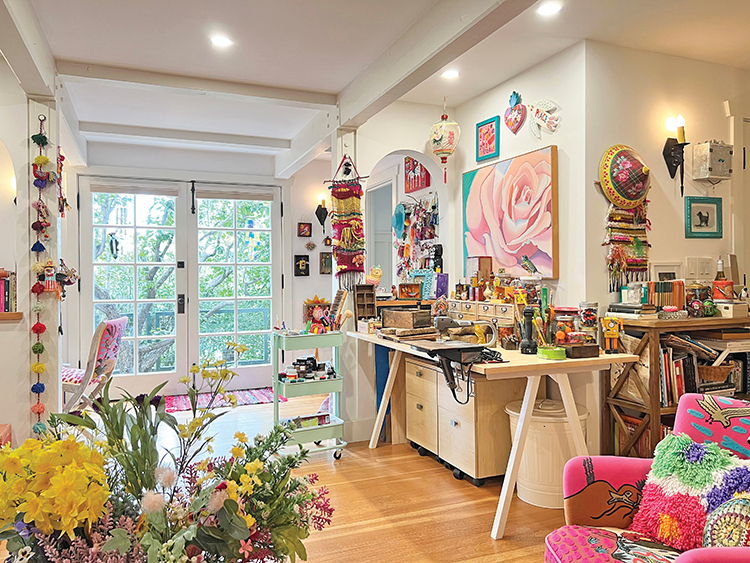
I attended University of California, Berkeley, where I planned on becoming a journalism major. I was always very politically active and still am. But from my very first semester, I took art electives. I was lucky to have taken classes with some amazing California artists, including painter Joan Brown, printmaker David Goines, and conceptual media artist Lynn Hershman Leeson. I left journalism behind and graduated with a degree in graphic design so I could get a job!
For years, I worked as an art director and graphic designer for advertising and packaging within the entertainment industry. I really did love it for a time. It was the pre-computer era and one had to know how to draw and spec type, and have a background in art and design history, to be any good. I had a dream job designing album covers for a major music label, but it was hard to keep up with my own art practice while working in a visual field.
So, I took some time off to continue making art and taking art classes, including a graphic photo montage class taught by Cindy Marsh, one of the founding members of the Women’s Graphic Center at the Woman’s Building in LA.
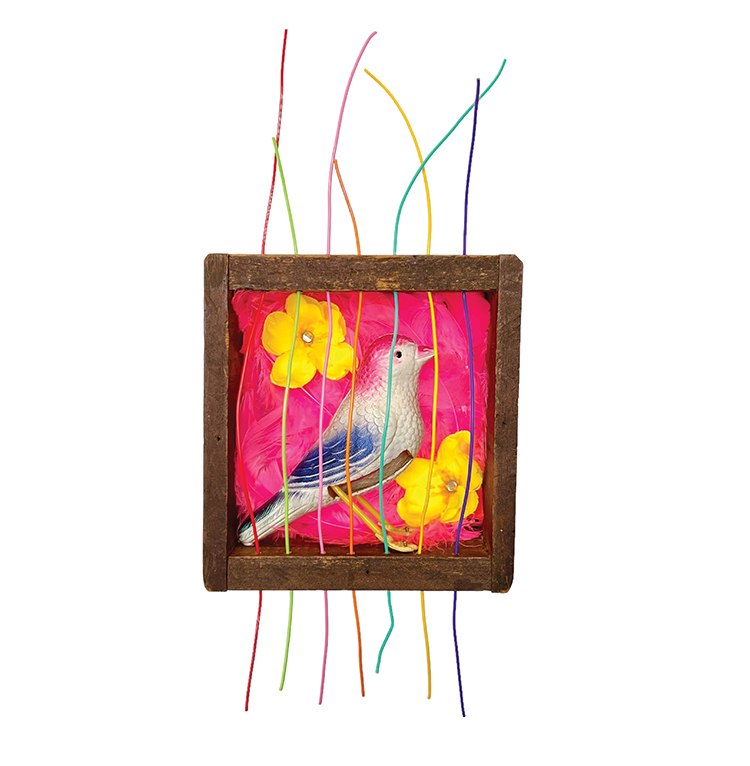
After I got married in the early 80s, my husband and I traveled extensively in Mexico and South America. I was completely mesmerized by Latin American culture and folk art. The materials, the colors, the soul of it. From nichos to nativity scenes with chalkware animalitos. All beautiful, surreal worlds — dioramas in full glory!
Around this time, I began creating what I have dubbed my Spirit Houses. Influenced by Latin American, Thai and Jewish folk art, I built wooden boxes with hinged doors. I created collages of ephemera, leaves and fabrics — framed in hand-embossed tin frames — to become the background of each box. I then built out each diorama with three-dimensional objects, some of which I brought back from my travels, and others found in the remarkably rich cultural centers of Chinatown, Little Tokyo and Olvera Street, right here in Los Angeles. I loved combining different materials: colored sand, faux flowers, marbles, sequins and tulle, to name a few, all fused in the cultural influences of a true Angeleno.
In the early 90s, I became a mom and published two children’s books, which I wrote and illustrated. And then I had the opportunity to design my largest diorama yet, a set for a Los Angeles theater company!
In 2010, I was diagnosed with amyloidosis. I would eventually have a stem cell transplant and then a kidney transplant (from my wonderful sister). Recovery was long and hard, but creating art was a major part of my healing process.
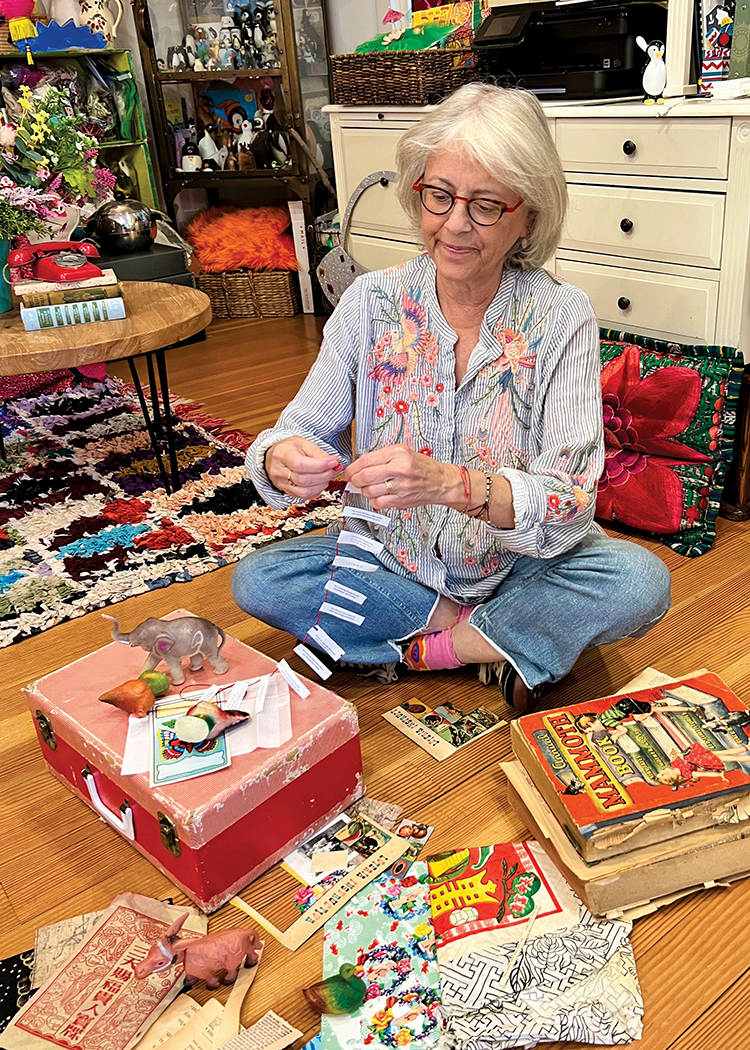
As I always loved set design and building little worlds with my hands, I created a series of 3D sets for my rescue dogs, Chester and Stella (aka @HolyTerriers on Instagram). Each doggy diorama is handmade using wood, paper, paint and found objects. No Photoshop, filters or computer tomfoolery!
When the pandemic began, being immunocompromised, I was terrified. I basically stayed home like Rapunzel (without the long blond hair) locked up in a tower. Luckily, I live in the hills, which are filled with trees, plants and lots of birdlife and I could be outside with my dogs. My passion for birding was renewed, but I still wasn’t in the headspace to create art.
Spending time on Instagram, I came across a wonderful account and soon joined the @WhimsyandWonderArtClub. It was just the fun and inspiring kick in the pants I needed! I’m so grateful for this supportive group, which helped reestablish my art-making passion.
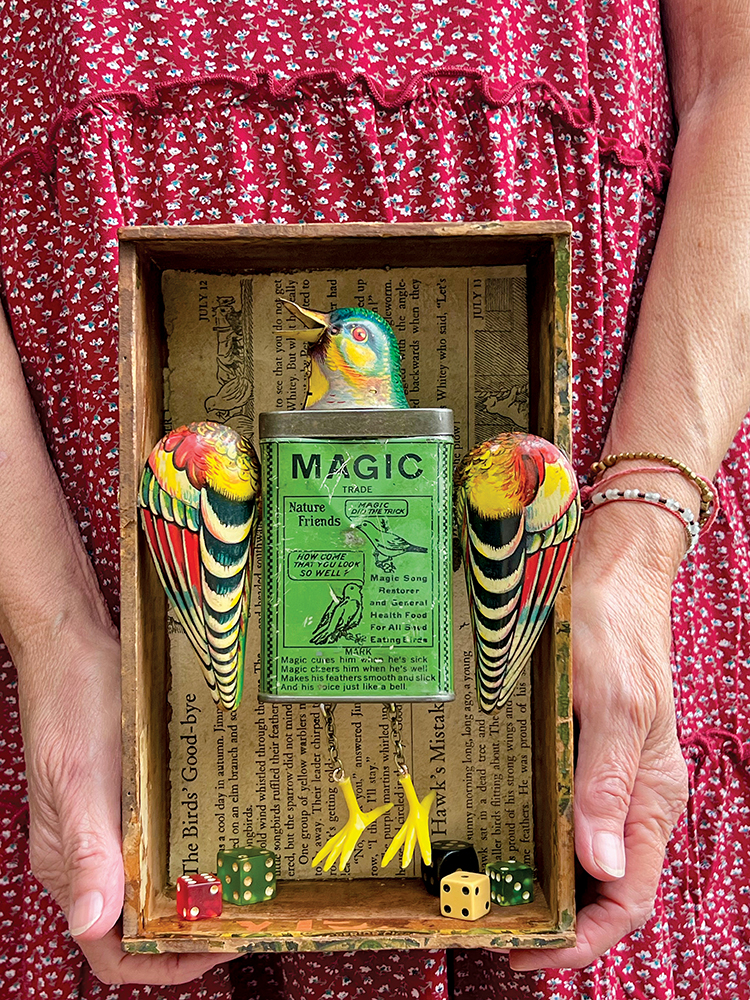
For a year, I made food sculptures to get out of my head, challenge myself and just have fun. And soon, I found my way back to my first loves, assemblage and dioramas.
Imagination has always been my sanctuary, and art my escape to a safe and happy place. My dioramas are self-contained imaginary worlds where anything is possible.
Sometimes an idea for a new assemblage just pops into my head. Other times, I’m inspired by a prompt.
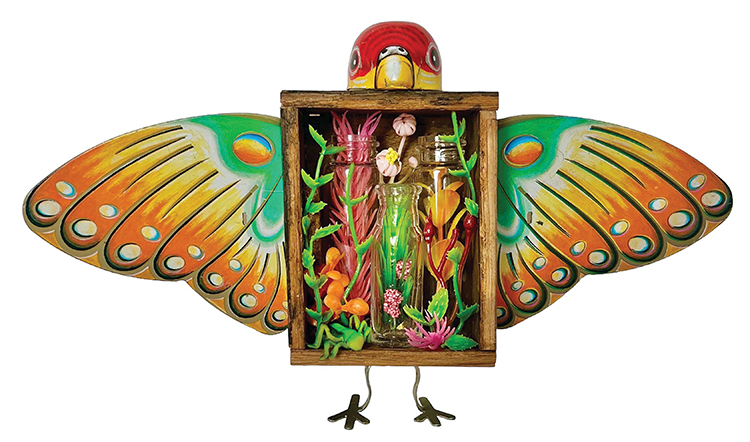
In July of this year, Trash Lamb Gallery, a cool space in San Diego’s South Park neighborhood, had a call for art for a show titled Survival is Insufficient. Submitted art had to imagine a planet in a distant universe that was overgrown with an abundance of exotic flora, but where no sentient beings existed. I instantly knew I wanted to invent mechanically engineered birds that flourished on plant life.
When I begin thinking about creating a new piece, I often know immediately what the main components of the work will be made of. I usually “see” most of the items from my collections in my head.
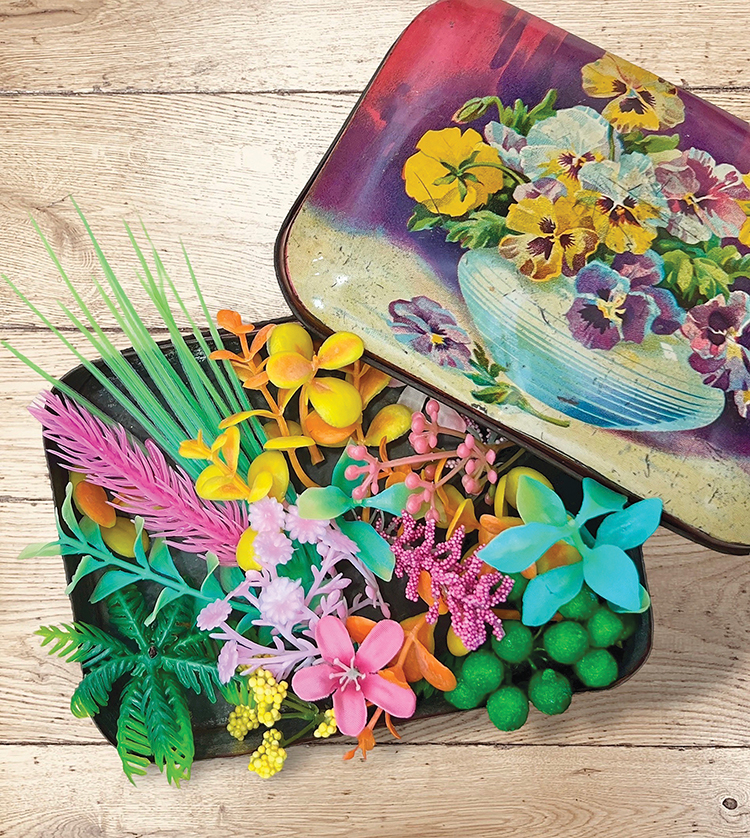
I go through my collection of found objects and begin to pick and choose to see what works. Creating assemblages is like painting with objects. Which pieces go together? Do they balance? How do the colors meld? What is the narrative created by the juxtaposition of the objects?
I find the perfect small and very rustic box for the as-yet unbuilt body. I choose a tin bird head, not plastic. Going through my stash of wings, I like how the butterfly wings seem more exotic than bird wings. I pay close attention to size, color and texture, and then I play around with the parts until I land on what the emerging creature wants to be. I sometimes feel like a mad scientist dissecting parts to piece together.
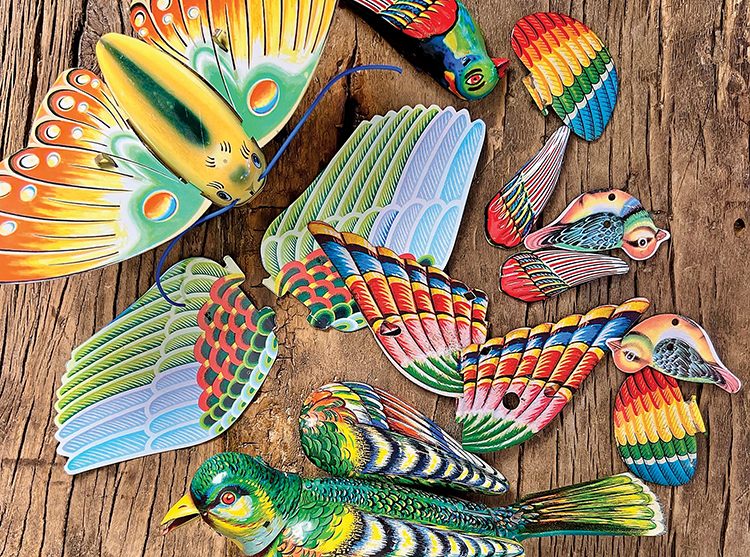
Finally, it’s time to attach the bird parts to the box. Each element requires a different way to be anchored. I use whatever is necessary to hold a piece together: glue, hammer and nails, drill and screws, miscellaneous hardware, and even soldering. Problem-solving is one of my favorite parts of creating.
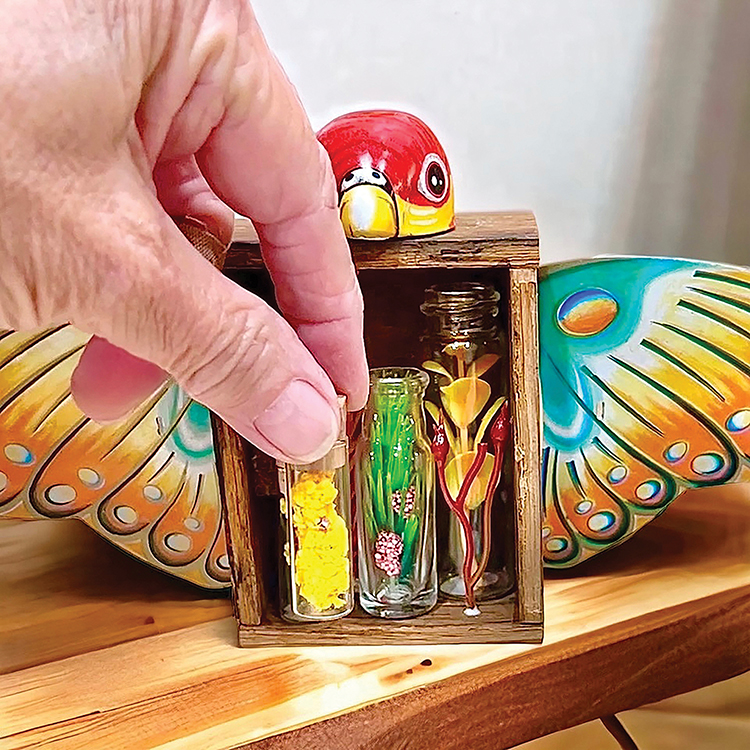
Now, the center of the piece, the box, is still empty. To elevate the finished artwork, I know the inside of the bird’s body has to tell a compelling story, in addition to looking fantastic. Thinking about the planet’s exotic flora, I go through my collection of vintage plastic aquarium plants and select some bright fluorescent ones. I cut them up and play around with different color combinations, but something is still missing.
I get excited when I hit on the idea to use small glass bottles to emulate beakers from a science lab. I fill three small glass bottles with three different colors of the plastic plants, then fill out the box with extra faux plants to carefully craft an exotic but miniature overgrown garden. I mix and match materials until I reach that “aha” moment when I just know it feels right. Lastly, I add a vintage plastic bug for a pop of color and touch of whimsy.
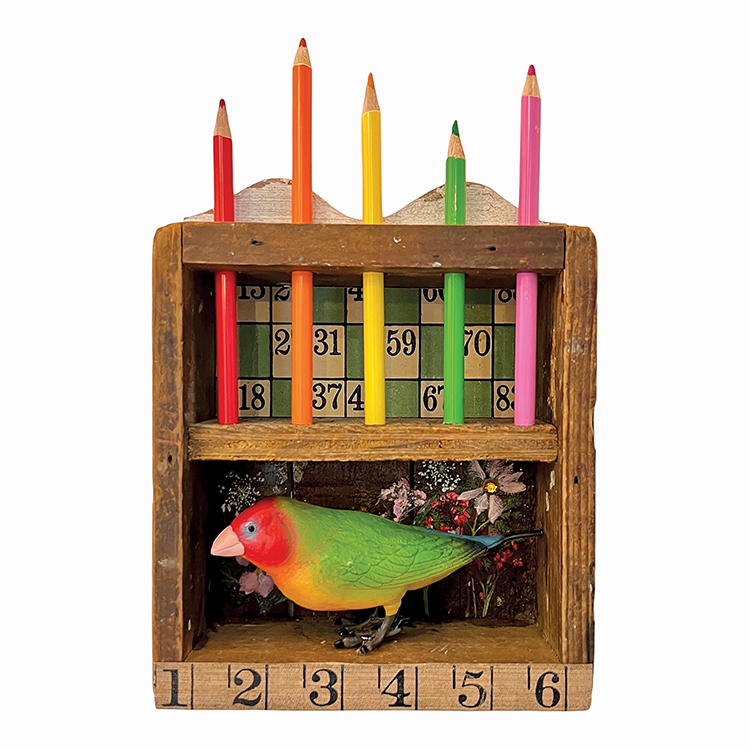
I create a lot of bird dioramas. As an environmental activist, I am passionate about the earth and animals. Birds are the literal canaries in the coal mine. Metaphorically, I share the plight of these beautiful creatures by showing them captive but about to break free.
I am often asked where I find the materials I use in my assemblages. I’ve always been a collector of almost everything. I still frequent thrift stores and flea markets to seek out unusual finds. Vintage items used to be so much easier to come by, especially old wooden boxes! But, if I don’t find the right box, I’ll build one. Luckily, I have a great local resource for funky, vintage wood.
My collection of materials includes old plastic and tin toys, baby doll parts, wooden cigar boxes, old watch parts, rusted metal, vintage tin spice boxes and so much more. I also love ephemera, including ethnic paper products like Mexican papel picado, Chinese laser cut and dyed tissue, vintage Japanese water flower packs and — woohoo! — glassine envelopes. I have boxes of this stuff and nothing gets thrown away because I never know when I might need it for a new piece of art!
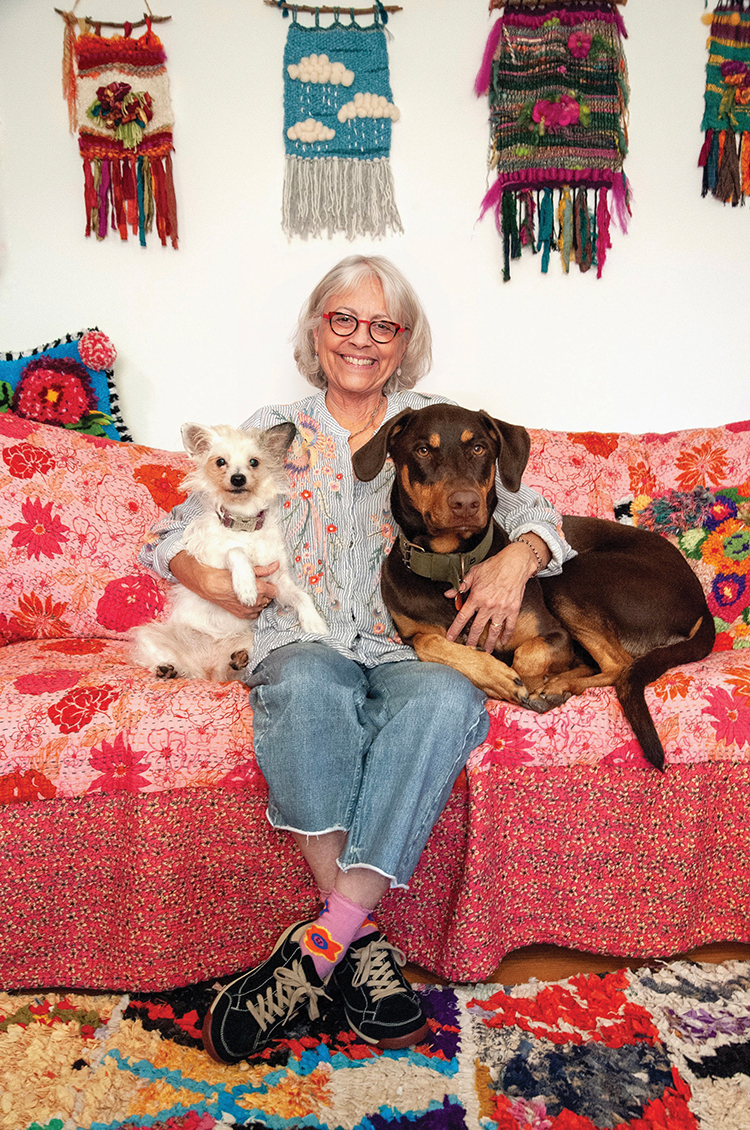
I feel so grateful that I am able to work doing what I love. Inspired by nature and these magical found objects, I create fantasy dream worlds of whimsy and wonder. Please don’t wake me up!
My vision is to turn a plain white room — let’s say a 12-foot-by-12-foot square — into a walk-in diorama/installation. I can picture the items I’d use. They would mostly be miniature, so there would need to be a lot of pieces to fill the space: bits of paper with writing, colored string and lots of colorful tiny objects. And it will tell a story that I haven’t written yet.

I grew up in the San Fernando Valley (a suburb of Los Angeles) when it was still filled with orange groves and neighbors rode by on horseback. My street had no sidewalks and it was safe for us neighborhood kids to ride our bikes and explore construction sites (collecting the slug cutouts from electrical boxes) and feed the ducks at the unfenced lake at the historical Encino Adobe.
Not everything was carefree, however. As a child of a Holocaust survivor, I was raised amid fear, distrust and anxiety. Beginning in childhood, creating art was my happy place. I was a tomboy who loved being outside playing kickball, but you would often find me in my room drawing, painting or building something. Art was always my favorite subject.

I attended University of California, Berkeley, where I planned on becoming a journalism major. I was always very politically active and still am. But from my very first semester, I took art electives. I was lucky to have taken classes with some amazing California artists, including painter Joan Brown, printmaker David Goines, and conceptual media artist Lynn Hershman Leeson. I left journalism behind and graduated with a degree in graphic design so I could get a job!
For years, I worked as an art director and graphic designer for advertising and packaging within the entertainment industry. I really did love it for a time. It was the pre-computer era and one had to know how to draw and spec type, and have a background in art and design history, to be any good. I had a dream job designing album covers for a major music label, but it was hard to keep up with my own art practice while working in a visual field.
So, I took some time off to continue making art and taking art classes, including a graphic photo montage class taught by Cindy Marsh, one of the founding members of the Women’s Graphic Center at the Woman’s Building in LA.

After I got married in the early 80s, my husband and I traveled extensively in Mexico and South America. I was completely mesmerized by Latin American culture and folk art. The materials, the colors, the soul of it. From nichos to nativity scenes with chalkware animalitos. All beautiful, surreal worlds — dioramas in full glory!
Around this time, I began creating what I have dubbed my Spirit Houses. Influenced by Latin American, Thai and Jewish folk art, I built wooden boxes with hinged doors. I created collages of ephemera, leaves and fabrics — framed in hand-embossed tin frames — to become the background of each box. I then built out each diorama with three-dimensional objects, some of which I brought back from my travels, and others found in the remarkably rich cultural centers of Chinatown, Little Tokyo and Olvera Street, right here in Los Angeles. I loved combining different materials: colored sand, faux flowers, marbles, sequins and tulle, to name a few, all fused in the cultural influences of a true Angeleno.
In the early 90s, I became a mom and published two children’s books, which I wrote and illustrated. And then I had the opportunity to design my largest diorama yet, a set for a Los Angeles theater company!
In 2010, I was diagnosed with amyloidosis. I would eventually have a stem cell transplant and then a kidney transplant (from my wonderful sister). Recovery was long and hard, but creating art was a major part of my healing process.

As I always loved set design and building little worlds with my hands, I created a series of 3D sets for my rescue dogs, Chester and Stella (aka @HolyTerriers on Instagram). Each doggy diorama is handmade using wood, paper, paint and found objects. No Photoshop, filters or computer tomfoolery!
When the pandemic began, being immunocompromised, I was terrified. I basically stayed home like Rapunzel (without the long blond hair) locked up in a tower. Luckily, I live in the hills, which are filled with trees, plants and lots of birdlife and I could be outside with my dogs. My passion for birding was renewed, but I still wasn’t in the headspace to create art.
Spending time on Instagram, I came across a wonderful account and soon joined the @WhimsyandWonderArtClub. It was just the fun and inspiring kick in the pants I needed! I’m so grateful for this supportive group, which helped reestablish my art-making passion.

For a year, I made food sculptures to get out of my head, challenge myself and just have fun. And soon, I found my way back to my first loves, assemblage and dioramas.
Imagination has always been my sanctuary, and art my escape to a safe and happy place. My dioramas are self-contained imaginary worlds where anything is possible.
Sometimes an idea for a new assemblage just pops into my head. Other times, I’m inspired by a prompt.

In July of this year, Trash Lamb Gallery, a cool space in San Diego’s South Park neighborhood, had a call for art for a show titled Survival is Insufficient. Submitted art had to imagine a planet in a distant universe that was overgrown with an abundance of exotic flora, but where no sentient beings existed. I instantly knew I wanted to invent mechanically engineered birds that flourished on plant life.
When I begin thinking about creating a new piece, I often know immediately what the main components of the work will be made of. I usually “see” most of the items from my collections in my head.

I go through my collection of found objects and begin to pick and choose to see what works. Creating assemblages is like painting with objects. Which pieces go together? Do they balance? How do the colors meld? What is the narrative created by the juxtaposition of the objects?
I find the perfect small and very rustic box for the as-yet unbuilt body. I choose a tin bird head, not plastic. Going through my stash of wings, I like how the butterfly wings seem more exotic than bird wings. I pay close attention to size, color and texture, and then I play around with the parts until I land on what the emerging creature wants to be. I sometimes feel like a mad scientist dissecting parts to piece together.

Finally, it’s time to attach the bird parts to the box. Each element requires a different way to be anchored. I use whatever is necessary to hold a piece together: glue, hammer and nails, drill and screws, miscellaneous hardware, and even soldering. Problem-solving is one of my favorite parts of creating.

Now, the center of the piece, the box, is still empty. To elevate the finished artwork, I know the inside of the bird’s body has to tell a compelling story, in addition to looking fantastic. Thinking about the planet’s exotic flora, I go through my collection of vintage plastic aquarium plants and select some bright fluorescent ones. I cut them up and play around with different color combinations, but something is still missing.
I get excited when I hit on the idea to use small glass bottles to emulate beakers from a science lab. I fill three small glass bottles with three different colors of the plastic plants, then fill out the box with extra faux plants to carefully craft an exotic but miniature overgrown garden. I mix and match materials until I reach that “aha” moment when I just know it feels right. Lastly, I add a vintage plastic bug for a pop of color and touch of whimsy.

I create a lot of bird dioramas. As an environmental activist, I am passionate about the earth and animals. Birds are the literal canaries in the coal mine. Metaphorically, I share the plight of these beautiful creatures by showing them captive but about to break free.
I am often asked where I find the materials I use in my assemblages. I’ve always been a collector of almost everything. I still frequent thrift stores and flea markets to seek out unusual finds. Vintage items used to be so much easier to come by, especially old wooden boxes! But, if I don’t find the right box, I’ll build one. Luckily, I have a great local resource for funky, vintage wood.
My collection of materials includes old plastic and tin toys, baby doll parts, wooden cigar boxes, old watch parts, rusted metal, vintage tin spice boxes and so much more. I also love ephemera, including ethnic paper products like Mexican papel picado, Chinese laser cut and dyed tissue, vintage Japanese water flower packs and — woohoo! — glassine envelopes. I have boxes of this stuff and nothing gets thrown away because I never know when I might need it for a new piece of art!

I feel so grateful that I am able to work doing what I love. Inspired by nature and these magical found objects, I create fantasy dream worlds of whimsy and wonder. Please don’t wake me up!
My vision is to turn a plain white room — let’s say a 12-foot-by-12-foot square — into a walk-in diorama/installation. I can picture the items I’d use. They would mostly be miniature, so there would need to be a lot of pieces to fill the space: bits of paper with writing, colored string and lots of colorful tiny objects. And it will tell a story that I haven’t written yet.












